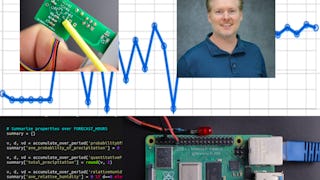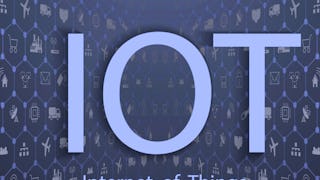In this Capstone course, you will design a microcontroller-based embedded system. As an option, you can also build and test a system. The focus of your project will be to design the system so that it can be built on a low-cost budget for a real-world application. To complete this project you'll need to use all the skills you've learned in the course (programming microcontrollers, system design, interfacing, etc.). The project will include some core requirements, but leave room for your creativity in how you approach the project. In the end, you will produce a unique final project, suitable for showcasing to future potential employers.

Enjoy unlimited growth with a year of Coursera Plus for $199 (regularly $399). Save now.

Programming for the Internet of Things Project
This course is part of An Introduction to Programming the Internet of Things (IOT) Specialization

Instructor: Ian Harris
27,741 already enrolled
Included with
(947 reviews)
Skills you'll gain
Details to know

Add to your LinkedIn profile
See how employees at top companies are mastering in-demand skills

Build your subject-matter expertise
- Learn new concepts from industry experts
- Gain a foundational understanding of a subject or tool
- Develop job-relevant skills with hands-on projects
- Earn a shareable career certificate

There are 6 modules in this course
This section will answer questions you might have about the project assignment, the grading rubric, and what you can expect in the upcoming weeks together.
What's included
1 video5 readings
This module will assist you in selecting an idea for your Capstone project. There are many variables to consider in this decision so it's important to know the parameters and how they impact your choice. Your decision will then drive the content of the very first step in your Capstone project -- preparing a requirements specification.
What's included
3 videos1 peer review
With the requirements specification out of the way, it's time to turn your attention to the system-level design of your project. This module will walk you through the constraints your project will need to satisfy. You'll also be informed about how to consider alternatives to your design.
What's included
2 videos1 peer review
Naturally testing is a key component of any technical design. This module will walk you through the important aspects of a test plan for your design.
What's included
1 video1 peer review
In this final module, you will have the option of actually building out and then demonstrating your final project. This module is optional because it requires you to have the necessary equipment.
What's included
1 video1 peer review
Let's wrap up our time together as we have traveled through the specialization.
What's included
1 reading
Earn a career certificate
Add this credential to your LinkedIn profile, resume, or CV. Share it on social media and in your performance review.
Instructor

Offered by
Explore more from Electrical Engineering
 Status: Free Trial
Status: Free TrialUniversity of California, Irvine
 Status: Free Trial
Status: Free TrialJohns Hopkins University
 Status: Free Trial
Status: Free TrialUniversity of California San Diego
 Status: Preview
Status: PreviewPohang University of Science and Technology(POSTECH)
Why people choose Coursera for their career




Learner reviews
947 reviews
- 5 stars
79.74%
- 4 stars
16.35%
- 3 stars
2.32%
- 2 stars
0.73%
- 1 star
0.84%
Showing 3 of 947
Reviewed on Oct 2, 2019
One of the most enjoyable courses that I have ever undertaken. Excellent structure, support and content.
Reviewed on Sep 10, 2019
A very interesting course. Students get the freedom to choose their own ideas and are allowed to implement it. Learnt how to approach a project logically and systematically.
Reviewed on May 19, 2020
Fun class for beginner concept acquisition of how to manipulate microcontroller outputs via the internet.

Open new doors with Coursera Plus
Unlimited access to 10,000+ world-class courses, hands-on projects, and job-ready certificate programs - all included in your subscription
Advance your career with an online degree
Earn a degree from world-class universities - 100% online
Join over 3,400 global companies that choose Coursera for Business
Upskill your employees to excel in the digital economy
Frequently asked questions
To access the course materials, assignments and to earn a Certificate, you will need to purchase the Certificate experience when you enroll in a course. You can try a Free Trial instead, or apply for Financial Aid. The course may offer 'Full Course, No Certificate' instead. This option lets you see all course materials, submit required assessments, and get a final grade. This also means that you will not be able to purchase a Certificate experience.
When you enroll in the course, you get access to all of the courses in the Specialization, and you earn a certificate when you complete the work. Your electronic Certificate will be added to your Accomplishments page - from there, you can print your Certificate or add it to your LinkedIn profile.
Yes. In select learning programs, you can apply for financial aid or a scholarship if you can’t afford the enrollment fee. If fin aid or scholarship is available for your learning program selection, you’ll find a link to apply on the description page.
More questions
Financial aid available,
¹ Some assignments in this course are AI-graded. For these assignments, your data will be used in accordance with Coursera's Privacy Notice.

